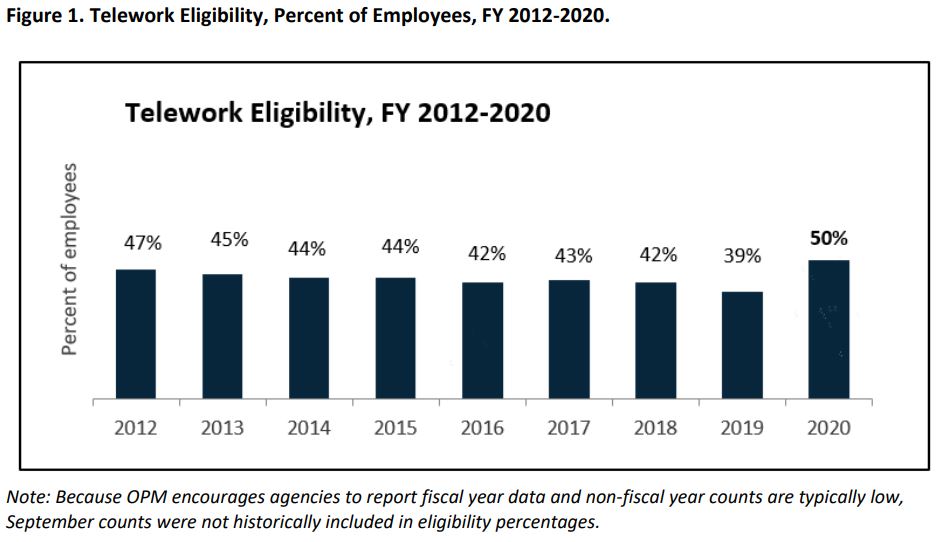New data surrounding the fiscal year proves that 2020 had the highest rates of telework participation and eligibility in nearly a decade, largely because of the COVID-19 pandemic. The Office of Personnel Management’s (OPM) 2020 Federal Employee Viewpoint Survey also explored the impact of telework and the pandemic on federal workers’ engagement and morale, but did so through employees’ self-reporting telework status.
According to OPM’s latest report to Congress, federal agencies reported 45% of all employees teleworked in 2020, which is a very high statistic compared to the 22% of feds that teleworked in both 2019 and 2018. The rate was higher for those actually eligible for telework. Of those eligible to telework, 90% did so in fiscal year 2020 compared to 56% in 2019 and 51% in 2018.
“During fiscal year 2020, agencies used telework as a strategic management tool to enhance their capability to achieve critical outcomes during an unprecedented time. Where appropriate, agencies throughout the federal government expanded telework to the maximum extent possible to protect the health and safety of the federal workforce and the American people,” OPM Director Kiran Ahuja said in the report summary.
Telework eligibility itself was naturally on the rise in 2020, after sinking in 2019. Half of federal employees were eligible for telework in 2020 compared to 39% in 2019 and 42% in 2018.
The OPM’s new report is dated December 2021, a year later, which is a standard time of release for such data. The statistics were collected via an online survey of 91 agencies (87 engaged) from November 1st to December 12th, 2020. The report also includes “relevant findings” from the 2020 OPM Federal Employee Viewpoint Survey, which OPM said “may not be completely representative of one another” but still “allows for the reasonable assessment of correlative relationships between teleworkers’ experiences and employee outcomes.”
OPM attributed these increases to the pandemic and policy changes. For years prior to the pandemic, the agency has also been encouraging organizations to create annual telework goals and develop potential cost savings. In 2020, 72% of agencies reported meeting their telework participation goals, or 25% more than in 2019. Agencies are simultaneously getting better at calculating the cost savings, including factors like real estate and energy costs, commuting and transit costs, training and employee absences. A total of 64% of agencies managed to track those savings in 2020, once again up from 52% in 2019.
According to these agency responses, OPM has concluded that the federal government saved $180 million in 2020 due to telework, 40% of which was because of reduced commuting, while 17% was caused by fewer employee absences. 26% of the savings unsurprisingly developed from lower utilities, rents and office space costs.
“This experience makes clear that, that when implemented correctly, telework can help us deliver on our mission,” Ahuja said. “As we look to the future, OPM is encouraging agencies to strategically leverage workplace flexibilities such as telework to help attract, recruit and retain the best possible workforce, as well as leverage telework as a way to ensure greater resiliency and emergency preparedness through the federal government.”
With the savings reported, it is safe to expect more remote work from home or telework from agencies in general for the federal workforce in 2022.

